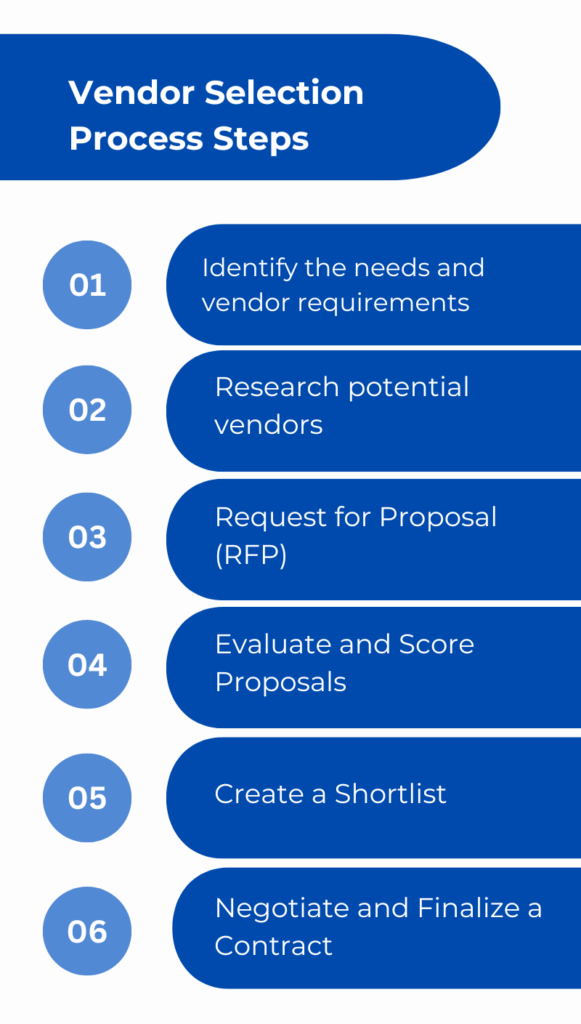Vendor selection is a crucial component of procurement –serving as the foundation for engaging with dependable suppliers that can fulfill organizational needs efficiently.
This blog explores the significance of strategic vendor choice, identifying common pitfalls to avoid and offering actionable insights for implementing an effective vendor evaluation process.
We’ll cover essential steps of the selection process, discuss key selection criteria and share practical tips, explore how Ivalua’s Supplier Management Software can streamline and enhance your vendor selection efforts
Why Vendor Selection is Important
A vendor – also known as a supplier – is an individual or a company that provides goods or services to another company. Vendors play a crucial role in the supply chain, as they provide the necessary products and services that a business needs to operate.
Vendors can be involved in both direct and indirect procurement:
- Direct Procurement: This involves the purchase of raw materials, components or goods that are directly used in the production process or in delivering services. For example, a car manufacturer purchasing steel and engine components from vendors.
- Indirect Procurement: This includes the purchase of goods and services that are not directly related to the production process but are necessary for the business’s operations. Examples include office supplies, IT services and maintenance services.
Choosing the wrong vendor can result in higher costs and risk due to inefficiencies, poor-quality materials or services and delivery delays. These issues disrupt production schedules and can damage the company’s reputation.
Learn more about direct and indirect procurement in our comprehensive guide.
Benefits of an Effective Vendor Selection Process
Selecting vendors based on clear criteria ensures organizations partner with suppliers that deliver high-quality products or services. It helps to maintain consistent quality standards and meet customer expectations, which leads to a positive brand reputation and increased customer satisfaction.
According to Forrester and Ivalua, only 13% of business leaders have formal supplier management processes in place – which means there’s lots of room for improvement.
A structured vendor selection process involves setting clear performance criteria and key performance indicators (KPIs), such as meeting delivery deadlines, the quality of goods or services and pricing structure. By defining these KPIs, businesses can better evaluate potential suppliers and make informed decisions, ensuring high standards are maintained.
By identifying reliable, low-risk vendors with proven track records, you can be confident products and services will be of high quality and delivered on-time, with minimal disruptions. You’ll be more successful at building long-term, collaborative partnerships and take advantage of opportunities for joint innovation and growth.
Learn more about the benefits of an effective supplier performance management (SPM) program, to ensure vendors fulfill all project requirements.
What Are the Steps in the Vendor Selection Process?

Let’s walk through the key steps in a solid vendor procurement process:
- Identify the needs and vendor requirements: The first step is to determine what’s needed. For example, perhaps your company requires an upgrade to its IT infrastructure to enhance efficiency and productivity.
- Research potential vendors: Next, you need to gather information on different vendors’ capabilities, expertise, reputation and track record in IT infrastructure upgrades. Generative AI in procurement can dramatically reduce the time required to identify suitable suppliers by 90% or more..
- Request for Proposal (RFP): After you’ve investigated potential vendors, it’s time to prepare and distribute a detailed RFP outlining project requirements, goals, timelines and vendor evaluation criteria, and invite the vendors to submit proposals.
- Evaluate and Score Proposals: Once you receive the RFPs, you need to assess the proposals based on criteria such as technical expertise, proposed solutions, pricing, delivery timelines and past performance. Each proposal should be scored objectively against predefined criteria to facilitate comparison. Again, Artificial Intelligence can help speed up this process.
- Create a Shortlist: Once you’ve evaluated the RFPs, create a shortlist of top vendors then initiate negotiations around pricing, project scope, deliverables and contract terms.
- Negotiate and Finalize the Contract: Selects the vendor that best meets project requirements and aligns with your company’s goals. The final step is to formalize the agreement by drafting and executing a contract detailing project specifications, timelines, deliverables, payment terms, warranties and dispute resolution methods.
Vendor Selection Criteria Checklist
The following checklist outlines and describes recommended criteria for evaluating vendors. The vendor criteria you choose for your evaluation will depend on your company’s specific goals and objectives.
| Criteria | Description |
| Experience,Expertise, and Capabilities | Evaluates the vendor’s experience in the industry and their expertise in providing the required goods or services. This includes assessing their track record, past projects and specialized knowledge, and capabilities (e.g., technical and process knowledge, equipment, etc.) to deliver/produce products and services. |
| Quality of Products/Services | Assesses the quality of the products or services offered by the vendor. Examines factors such as product/service specifications, certifications, compliance with industry standards and any quality assurance processes in place. |
| Pricing | Consider the total landed and lifetime cost of products or services provided by the vendor. Includes evaluating pricing structures, pricing competitiveness in the market, transparency in pricing and any discounts or incentives offered for bulk purchases or long-term contracts. |
| Delivery Timelines | Examines the vendor’s ability to deliver products or services within the required timeframe. Assesses lead times, delivery schedules, shipping options and any guarantees or penalties associated with meeting or exceeding delivery deadlines. |
| Reliability | Assesses the vendor’s reliability in fulfilling orders and meeting commitments. Includes evaluating reputation for on-time delivery, consistency in product/service quality, responsiveness to inquiries and ability to handle unexpected challenges or disruptions. |
| Financial Stability | Evaluates the vendor’s financial health and stability. Examines factors such as profitability, liquidity, debt levels, cash flow and creditworthiness. (A financially stable vendor is less likely to face financial difficulties that could impact their ability to fulfill orders.) |
| Scalability | Considers the vendor’s capacity to scale production or services to meet future demand. Ensures the vendor can accommodate business growth or fluctuations in demand without compromising quality, timelines or pricing. |
| Compatibility | Assesses the compatibility between the vendor’s offerings and the organization’s needs, goals and values. Examines factors such as cultural fit, communication style, technological compatibility and alignment with corporate social responsibility (CSR) goals. |
| Customer Service | Evaluates the vendor’s customer service capabilities and responsiveness. Assesses the ease of communication, accessibility of support channels, responsiveness to inquiries or issues and willingness to collaborate and address customer concerns proactively. |
| Innovation | Consider the vendor’s ability to innovate and offer new solutions, technologies or approaches that can bring added value to the organization. Examines the vendor’s track record of innovation, investment in research and development and willingness to collaborate on innovation initiatives. |
These criteria help procurement professionals identify vendors that align with the organization’s objectives, deliver high-quality products or services and provide value-added benefits beyond just cost considerations.
For a comprehensive approach to supplier risk and performance management, download Ivalua’s Supplier Risk and Performance Management Checklist.
Practical Tips for Implementing a Vendor Selection Process
Procurement teams can optimize their vendor selection process by adopting practical strategies tailored to their sourcing projects. Here are some useful tips:
- Establishing Clear Collaboration & Communication Channels: Collaboration is critical to any successful partnership, and communication is a large component of this process. Effective communication is key to successful vendor relationships, aligning everyone on expectations and deadlines. Using tools like email, project management software, and regular video calls can help maintain clarity and consistency. Establishing these channels early on helps prevent misunderstandings and ensures smooth collaboration.
- Building Long-term Relationships: Long-term vendor partnerships offer advantages such as improved pricing and more resilient supply chains. To build and maintain these relationships, businesses should schedule regular check-ins, encourage open feedback, and collaborate on shared goals. Addressing challenges promptly fosters trust and strengthens supplier relationships.
- Regular Performance Review and Feedback: Setting supplier performance benchmarks and conducting regular reviews ensures vendors meet expectations. Maintaining open, ongoing communication helps clarify needs, driving better performance and strengthening the partnership.
Ivalua’s supplier management software, leverages the capabilities of Generative AI to expedite supplier research and gather pertinent information on potential vendors and their offerings.
How Chassis Brakes Cut Vendor Evaluation And Research Time by 90%
Chassis Brakes, a leading manufacturer of automotive braking systems, wanted to enhance their vendor selection and supplier management processes to improve efficiency, reduce costs and ensure high-quality standards.
Facing challenges such as fragmented supplier data, an inefficient selection process and onboarding delays, they decided to implement a structured vendor selection process leveraging Ivalua’s vendor management software.
Leveraging Ivalua’s AI-driven solution, the company cut vendor evaluation and research time by 90%. They also benefited from:
- An objective vendor evaluation process and selection of reliable suppliers
- Effective performance tracking and risk mitigation
- Quicker integration of new suppliers, reducing delays
- Centralized, accurate supplier data for better decision-making
“Ivalua has enabled our transformation journey effectively, making Procurement more agile and digital,” said Cyrille Naux, Executive VP of Purchasing and Supply Chain, Chassis Brakes “It really began with a focus on suppliers and clean supplier master data to make better decisions. Resolving this empowered efficiency, visibility, and much more value creation for the business.”
Read the full Chassis Brakes case study to learn how to modernize your vendor management and selection processes.
Speed up Vendor Selection With Ivalua
Ivalua’s Supplier Management Software and Sourcing Solution can save you time in the vendor selection process so that you can focus on more strategic tasks. Below are some concrete examples:
- By automating scoring templates, questionnaires and campaigns, the software significantly reduces the manual effort required from procurement professionals, streamlining the sourcing process, and cutting down on the time and resources needed to evaluate potential suppliers.
- Ivalua provides robust tools for analyzing supplier risk and performance throughout the entire supplier lifecycle, helping you to identify and mitigate risks early and ensuring reliable supplier performance.
- Ivalua offers intuitive tools for managing vendor selection campaigns, including templates, communications, stakeholder evaluations and project management features, to simplify the process of coordinating and executing supplier management campaigns.
- Benefit from proven sourcing tools, like sourcing optimization, that streamline and automate the review and analysis process for supplier proposals and the selection process. Ivalua enables buyers to evaluate quantitative and qualitative data, ensuring that price, risk, performance, ESG, and any other considerations are considered, and then a contract is rapidly negotiated and executed.
By centralizing and standardizing these core processes, Ivalua’s solutions enable organizations to achieve significant time and cost savings while maintaining high standards of supplier performance and risk management. Watch this brief video to learn more about Ivalua’s vendor management software.
Choose the Right Vendors for Your Business
With a formal vendor selection process in place – and with the help of Ivalua’s Supplier Management software – you can mitigate risks, optimize operational efficiency, and foster strategic partnerships with vendors.
Watch our Supplier Management demo and get started today!




